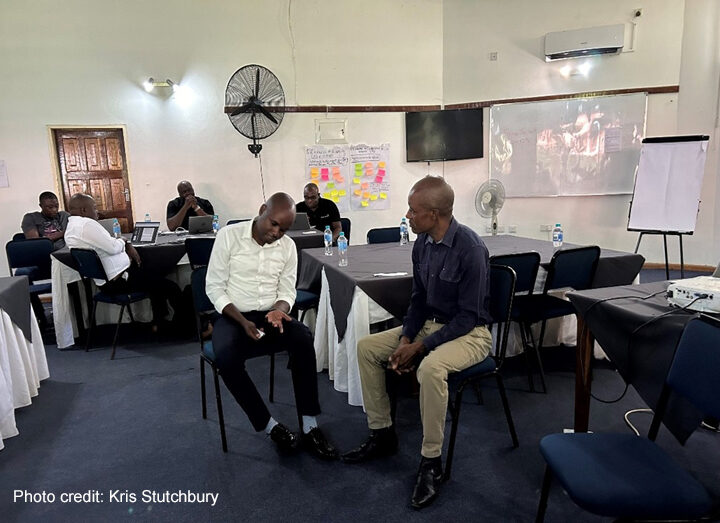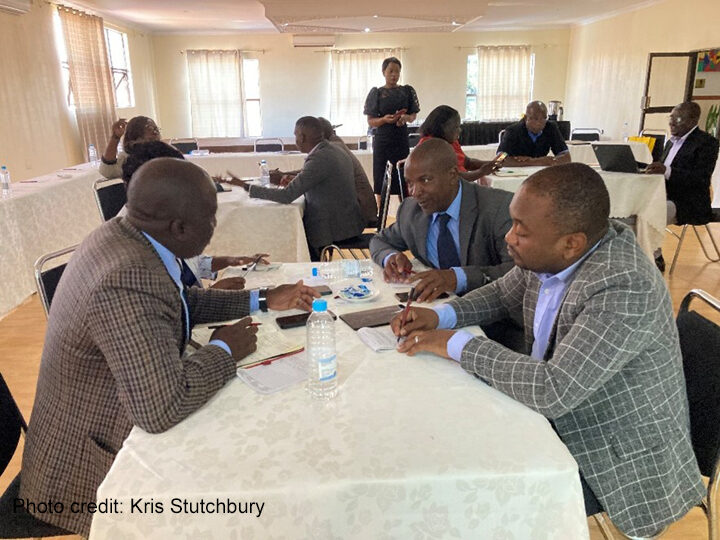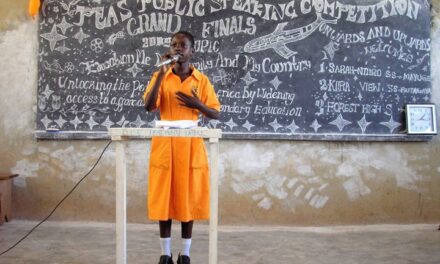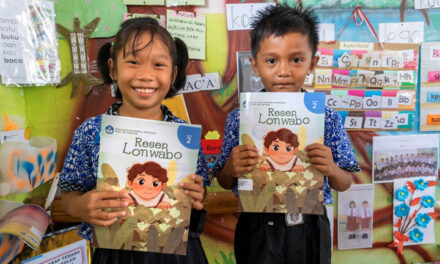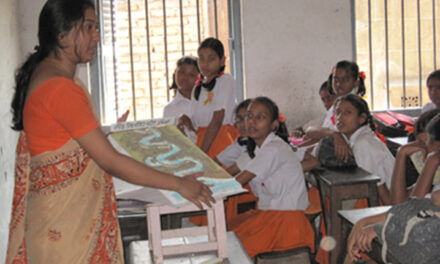Image caption: A role play activity: modelling supportive conversations between a headteacher and teacher.
This blog is written by Kris Stutchbury, Jennifer Agbaire (The Open University UK), John Phiri and Kalaluka Kalaluka (World Vision Zambia).
There is much focus on the “middle tier” in education systems in low- and middle-income countries at present. The middle tier describes groups of professionals at county, zone, district or provincial level whose role is to monitor and support schools. They are the people who often become master trainers or are tasked with supporting the implementation of a new curriculum or new initiative. The middle tier acts as a mediator between policymakers (top leadership) and implementers (teachers). We have argued that they are key actors in the implementation of high quality teacher professional development at scale, but that they often lack the knowledge, skills and professional development opportunities to carry out this role effectively.
Joseph is an Assistant District Resource Centre Coordinator (ADRCC) in Zambia. He is thrilled to have been recently promoted to this role. He had always been meticulous in preparing his lesson plans correctly, maintaining the School Inservice Record when he was his school’s School Inservice Coordinator and volunteering to facilitate Teacher Group Meetings. He enjoyed passing on his wisdom about how to teach certain topics to those less experienced than himself. Part of his new role is to support teachers in implementing new approaches with fidelity. He is looking forward to the opportunity to attend workshops run by the various NGOs, as he is a little unsure about some of the new ideas around “active learning” that are being introduced.
His first few months as an ADRCC were eye-opening. When he went into schools, he commanded respect. In fact, teachers seemed a little scared of him. In one school, he suspects that a teacher had slipped away as he arrived, a sign of the mistrust and apprehension that can characterise interactions between teachers and district officers. One of his main tasks as ADRCC is to inspect continuing professional development records and teachers’ lesson plans. He noticed that some teachers seemed to find it very difficult to follow guidelines and use the correct format.
Joseph soon found that there were challenges in carrying out his role. It was difficult to get a vehicle to visit schools and at times there was no money for fuel. On a few occasions, he had to hitch a ride with NGOs when they went to brief teachers about the various initiatives. He himself was well-briefed on these initiatives and on those occasions, he observed some sessions to make sure that the teachers were implementing the prescribed activities correctly. On one such visit, a teacher asked him if she could use the activities from the NGO initiative differently; on another, a teacher wanted to change some of the activities. But the NGO staff were adamant that the activities be implemented as prescribed. They needed all teacher activities to be consistent across their programme for their impact evaluation. This put Joseph in a difficult position: support teacher adaptation for relevance or adhere to strict implementation for evaluation?
Joseph’s predicament is captured in the new capacity framework from UNESCO (IIEP), which highlights nine dimensions of the middle tier. These nine dimensions divide into three categories: structures, people, and collaboration. Perhaps the most challenging dimensions to address are those involving people:
- clarity of roles and responsibilities;
- competent and motivated staff; and
- a strong learning culture.
As part of the Empowering Teachers Initiative, our research is shedding light on these sensitive issues. As we started to investigate how teacher professional development (TPD) could be adapted for local contexts, we realised that the notion of “adaptation” is not widely accepted, and that teachers in Zambia experience tension between the government-mandated system (which grants schools autonomy in how they organise TPD) and NGO initiatives (which require them to act in certain ways). The middle tier is crucial in helping schools to navigate this tension, paying close attention to the three dimensions in the “people” category listed above.
One day during his second term as ADRCC, Joseph was introduced to people from another NGO. They were conducting research about how the government-mandated school-based TPD programme was being carried out and how teachers are engaging with it. They wanted to work with district officers like Joseph as co-researchers who would go with them to schools to interview teachers about their experiences.
Joseph’s first experience as a co-researcher was not very satisfactory. The NGO had given him a detailed list of questions to ask. But the teachers gave him very short, guarded answers and would hardly look him in the eye. He came away with quite a few questions unanswered. Afterwards, he discussed his experience with the NGO staff who had also been doing interviews and was perturbed to find out how much more some of them had got out of the teachers.
Joseph was determined to do better. He realised that it didn’t matter if he deviated from the script. He had to somehow get the teachers to open up to him. So on his next attempt, he led with curiosity. When he got short answers, he asked more questions, always in a collegial, non-threatening manner. He was amazed at what he found out.
One teacher admitted that she didn’t attend Teacher Group Meetings. When he asked why, the teacher said it was difficult for her to find someone to care for her baby as the childminder finished at 1pm to run her market stall and the meetings were held after school. He asked the teacher what arrangement would work better for her, then went and talked to the School Inservice Coordinator. Sometime later, Joseph learned that the school had changed the way they organised Teacher Group Meetings: with smaller groups of teachers, at times which suited everyone.
This moment marked a turning point in Joseph’s approach to his work as a middle tier actor. By shifting from monitoring to genuine dialogue, he began to see how his role could help unlock practical solutions and deeper insights from teachers themselves.
Empowered by this, after he had observed another teacher using group work, he asked her about it – how did she organise the groups? How long had it taken for the children to learn how to work collaboratively? Why did she give out different roles? He was amazed at how much he learnt. When she realised she was not being inspected, the teacher relaxed and even explained some of the difficulties she had.
Joseph himself had never used group work in his own teaching. One of the most rewarding things about his job is having the privilege of visiting other classrooms, as it gives him the opportunity to learn from other teachers and beyond that, to facilitate the sharing of good practice between schools.
Our work in the Empowering Teachers Initiative suggests that middle tier roles, when approached with openness and curiosity, can shift from monitoring to facilitating professional learning. More intentional, collaborative and inquiry-led practice by middle tier staff is emerging in our research districts. Joseph’s story is an anonymised vignette drawn from patterns we have observed in the Empowering Teachers Initiative that illustrates some promising shifts in the way in which monitoring is carried out.

